
Hurley Haywood, if that name doesn’t ring a bell, is one of the most illustrious racing car drivers ever to walk on a track. The legend has won just about everything it could in its time: 5 x the 24 Hours of Daytona, 3 x the 24 Hours of Le Mans, the 12 Hours of Sebring, the IMSA GT championship and a Trans-Am championship. At the top of its winning list: His first victory at the 24 Hours of Daytona in 1973 was a few years after he was forced to fight in Vietnam.
Based on the Carrera RS 2.7 (RS for «Renn Sport»), the RSR was created for the 1973 season, as a prototype following the FIA Group 4 rules.
«For Daytona, Porsche gave RS to two teams: Brumos and Penske (Sunoco livery)», explained Haywood. Compared to the production model, some modifications were made, among others: the rear wheels were 50 mm wider, the engine increased from 2.7 to 2.8 liters, the radiator installed at the front, a larger tank (120 liters), the rear aileron named “ducktail” which would become the visual signature of the model, the cage C-arm. And the integration of plastic elements such as doors, front hood and side windows.
The 1973 Porsche 911 RSR 2.8 liters produced 290 hp (213 kW). Weighing 900 kg, the weight/power ratio was efficient. A classic five-speed manual transmission. During its first racing season, Porsche launched a 3-litre version, followed in 1974 by a new 2.1-litre flat 6 turbo.
«We each received equal cars. Peter disassembled the entire vehicle to test the whole, and discovered some surprises about the car like the flywheel completely loose!» Peter informed Roger Penske, but Penske refused to heed his remarks. Conclusion: during the race, the inertia wheel of Roger Penske’s team was defeated and Mark Donahue at the wheel of his RSR was forced to retire. Haywood won 24 hours of Daytona 1973 in his Porsche 911 RS – the first RSR of all time.
A feature (not mechanical) on the Haywood RSR is that it was one of the first sports cars to be equipped with a radio to communicate with the stands. Before the race, we examined the interest of having a radio in the car. Peter, convinced, said we would use it for the race,” said Haywood. This radio was very useful when Haywood asked to go home immediately to change his windshield! A 240 km/h collision with a seagull sprayed the windshield and prevented Haywood from seeing comfortably in front of him. Half of the animal’s carcass was out of the car and the other half was inside. Unable to find a windshield right away (at that time there were not many spare parts), the team asked Haywood to drive as long as he could to find a solution. Haywood rode many laps with the dead gull stuck in the car.
…
…
Several refusals to lend them a new window, the mechanics of Brumos found in the parking lot, the 911 of a willing owner, for a fee to offload his windshield. When the bird was disassembled, the mechanics told Haywood to return to the stand to change it and clean the inside of his car by getting rid of the feathers, blood and what remained of the bird’s body. It took them 10 laps to find; disassemble and bring the windshield back to the Brumos stand.
The seagull incident worried the Brumos team especially as the second Porsche had already given up. It was unthinkable that neither of the team’s 2 cars would finish the 24 hours. But Haywood and Gregg improved their lap time after lap and a comfortable lead could no longer prevent Haywood and Gregg from winning.
The Brumos team remains the most successful team in the history of the 24 Hours of Daytona with four victories in 1973 and 1975 at the wheel of 911 Carrera RSR, in 1978 with a 935/77 and in 2009 with a Riley 3.9-litre Porsche engine.



